Please note: As an Amazon Associate I earn from qualifying purchases. I also work with other affiliate partners and may be compensated from the links below. Details here.
5 Best Large Sensor Compact Cameras in 2025 (Great Alternatives to Bulky DSLRs)
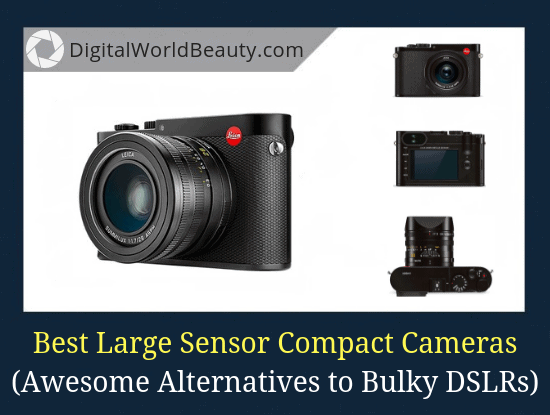
What is the best compact digital camera to buy?
The ones with the largest sensor. It is the soul of a digital camera.
The sensor is something that determines image size, how bright and sharp your photos are, or how well they perform in low light conditions.
And guess what?
Most modern compacts come with a 1″-type sensor size (or larger) which basically increase the quality of pictures.
So, if you’re looking for great alternatives to bulky DSLRs, then have a look at my list of the best large sensor compact cameras for 2025 (across various budgets and brands).
Here’s a table that’ll give you a quick look of my top 5 roundup and the reasons to buy the product. For further details, simply click ‘review>’ in respective row.
These compact cameras with 1 inch sensor and larger deliver exceptional image quality in portable packages.
Product | Image | Reasons to Get It | |
1. Leica Q Best high end compact camera |  |
| |
2. Fuji X100F Advanced compact camera for street & travel |  |
| |
3. Canon G9X II Best pocket camera for everyday photos |  |
| |
4. Lumix LX100 Best compact camera for travel |  |
| |
5. Ricoh GR II Best wide angle compact camera for street shooting |  |
|
When choosing which product to include, I didn’t focus on the ‘latest and the greatest’, but rather on great price-quality ratio options, even if they are older models.
In any case, whether you’re a complete newbie or an enthusiast, bootstrapped or not, you’ll find a good option that works best for your needs, skills, and budget.
Without further ado, let’s get started!
1. Leica Q (Typ 116)
Best Full Frame Sensor Compact (Fixed Lens)
Type: Large sensor compact | Weight: 640 g | Resolution: 24 MP | Sensor size: Full-frame (36 x 24 mm) | LCD screen: Fixed | Touchscreen: Yes | Weather-sealed: No | ISO: Auto, 100-50000
Reasons to Buy:
- very fast autofocus
- excellent image quality
- the build quality is amazing
- compact with full frame sensor
- pretty compact and lightweight
- great price compared to newer model
- great ergonomics and menu convenience
Reasons to Avoid:
- not super affordable to some people
- not very flexible configuration of function buttonsaverage battery life (get 2-3 Panasonic Lumix spare batteries)
I’ll say this right off the bat…
Leica Q hands down is one of the best premium compact cameras money can buy.
As a rule, Leica products have 2 things in common: insanely high price tags, and features and ergonomics close to perfection.
Either way, it’s a dream camera for many photographers.
Here’s why:
- burst rate up to 10 fps,
- extremely sharp focus,
- good low-light performance,
- great placement of manual dials,
- it offers outstanding image quality,
- quiet and vibration-free leaf shutter,
… Just to name a few.
Leica Q (Typ 116) is a premium large sensor point and shoot with a fixed 28 mm f/1.7 lens and a 24MP full-frame sensor.
This camera with biggest sensor in our compact lineup delivers DSLR-quality results in a portable form factor.
To give you perspective:
It sees the world as an iPhone but gives out photos slightly larger than that of 5D III – 6000 x 4000 px.
Some complain about 28 mm lens but, frankly, it just means you’ll have to physically move to change the distance. And the quality you get is sure worth it.
The f/1.7 lens takes great pics even in dim light conditions and is awesome for macro photography.
Speaking of which…
You’ll love love the ring to move from normal focus ranges to macro mode.
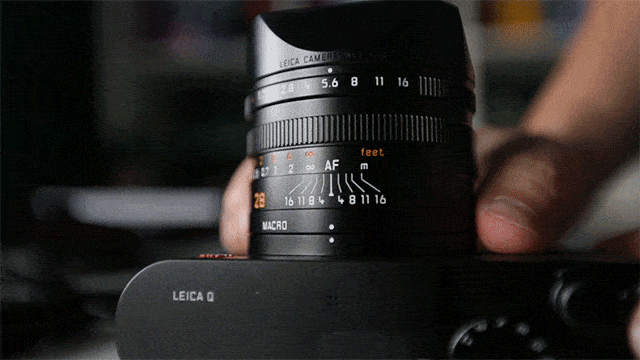
(Overall, the manual adjustments on the lens are fun to use.)
The autofocus is incredibly fast, you won’t have anything to complain about.
If we compare it with 5D III again with some fast lens, then I’d say they are approximately the same in terms of speed.
Without a doubt, Leica Q is one of the fastest large sensor premium compact cameras on the market today.
It is is best to use for the following genres:
- travel,
- macro photos,
- landscapes, and,
- street photography.
Important to note that while you can take decent landscape shots, I’d say it’s more of a walk around camera which is great for taking photos of your family, during travel, and for macro photography.
Remember that it’s a fixed 28 mm focal length.
Generally speaking, video recording is possible in Full HD at 50/60 fps.
However, it’s my understanding that Leica’s target audience isn’t so much interested in video than it is in stills.
This being said, it’s not trying to compete with Canon or Sony products in terms of video. If you’re you are into both photography and videography, then this list of the top rated cameras for hybrid shooters is for you.
All in all, I think Leica Q is close to perfection.
I mean…
- It shoots amazingly well,
- It has a nice minimalistic body,
- and doesn’t take up much space in your bag.
(Definitely a great choice for avid travellers.)
Note: This model is great, but if you can afford a newer one, it’s even better! You’ll absolutely love the Leica camera.
2. Fujifilm X100F
One of the Best Digital Compact Cameras
Type: Large sensor compact | Weight: 469 g | Resolution: 24 MP | Sensor size: APS-C (23.6 x 15.6 mm) | LCD screen: Fixed | Touchscreen: No | Weather-sealed: No | ISO: Auto, 200-12800 (expands to 100-51200)
Reasons to Buy:
- retro design
- great build quality
- Full HD video at 60 fps
- incredible image quality
- unique hybrid viewfinder
- best price-quality ratio digital camera
- 35mm lens resembles the perspective of the human eye
Reasons to Avoid:
- fixed lens
- autofocus could be better
- face detection is unreliable
Indeed it is. It is a premium compact with large sensor and that cool retro-design.
(Just like Leica Q it also comes with a fixed lens.)
This Fujifilm offers a unique hybrid viewfinder, has a solid metal construction yet is light (and pocketable), provides incredible image quality, has a great bokeh and a slightly wide focal length.
It gets a lot right!
If you specialize in street photography or just want to have the camera to document your life as you see it, then Fujifilm X100F is a really solid option for you.
As mentioned earlier, Fujifilm X100F offers a unique hybrid viewfinder. What it means is that it can work both in OVF and EVF.
The electronic viewfinder (EVF):
- Displays the image with the same brightness and color that you’ll see on the photo, though in low light conditions it might show a bit of digital noise.
The optical viewfinder (OVF):
- Provides a bright and clear picture in any shooting conditions, but it’s impossible to track the correct exposure and white balance on it.
And it’s made easy. Basically you have a switch and you turn the Hybrid OVF into a full fledged EVF.
Next, X100F features a 35mm equiv. f/2 fixed lens.
This means that you can rely on its confident work in low-light situations and you’ll have a nice background blur.
Now, it can be seen as a restriction in a sense that you can’t zoom in, for example, to shoot some sports events, but this focal length is sort of a benchmark for street and documentary photography.
Why?
Because 35mm focal length most closely resemble the perspective of the human eye.
And that’s why Fujifilm X100F is considered to be one of the best street/travel photography cameras today.
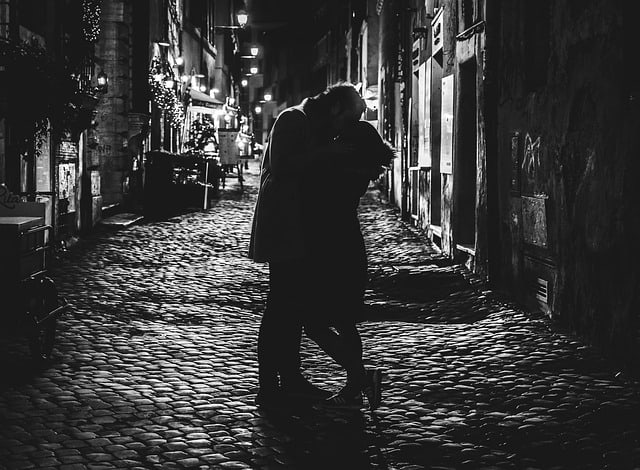
To be clear, while X100F is great for high quality street photography, it’s also suitable for (full-body) portrait shots, documentary, and, travel.
Some say that it’ll work for landscapes too, if you’re willing to think of it differently, but remember that it’s a 35mm focal length, so you’ll have clear shots of things that are within normal viewing distance.
All in all, Fuji X100F is nothing short of impressive.
It’s especially a great compact camera for travel and street photography.
And the price-value of this camera is amazing. You won’t find a better large sensor premium compact without spending thousands of dollars on it.
3. Canon PowerShot G9 X II
Budget Compact Digital Camera with 1 Inch Sensor
Type: Compact | Weight: 206 g | Resolution: 20 MP | Sensor size: 1″ (13.2 x 8.8 mm) | LCD screen: Fixed | Touchscreen: Yes | Weather-sealed: No | ISO: Auto, 125-12800
Reasons to Buy:
- quite accurate autofocus
- can charge via micro-USB
- small dimensions and weight
- best affordable pocket camera
- improved built-in image stabilizer
- large buffer for continuous shooting
- built-in Wi-Fi, NFC and Bluetooth interfaces
Reasons to Avoid:
- short battery life
- no tilting display screen
- can’t change most settings during video shooting
Low cost compacts with large sensors is a rare class of photography equipment.
Why?
Because the larger the sensor, the more expensive the camera is.
While the 1-inch type cameras are not as great as micro four-thirds, they still provide an awesome image quality.
A highly portable Canon Powershot G9X II is one of the best, most affordable compact cameras with 1 inch sensor on the market today.
This big sensor compact camera proves you don’t need to spend thousands for excellent image quality.
Its lens has a large aperture (f/2 in wide-angle position) and 3x optical zoom.
This viewing angle is approximately equal to that of the smartphone lenses.
It also offers a smart autofocus system, fast burst rate of 8.2 fps, and a built-in Intelligent image stabilization. All of this ensures that you have shake-free, sharp photos wherever you are.
(It’ll be enough even for dynamic documentary photography.)
If you’re tired of lugging your photography bag around and long for portability, Canon G9X II is a great alternative and has everything you need in a pocketable camera.
Its wide functionality, advanced technical characteristics, and the ability to provide excellent image quality (even in the difficult shooting situations) will allow you to take photos in any photography style of yours.
Think of this advanced point-and-shooter as a photographer’s notebook, which helps in the daily pursuit of awesome pictures.
Below is an example of on-the-go everyday life things captured:
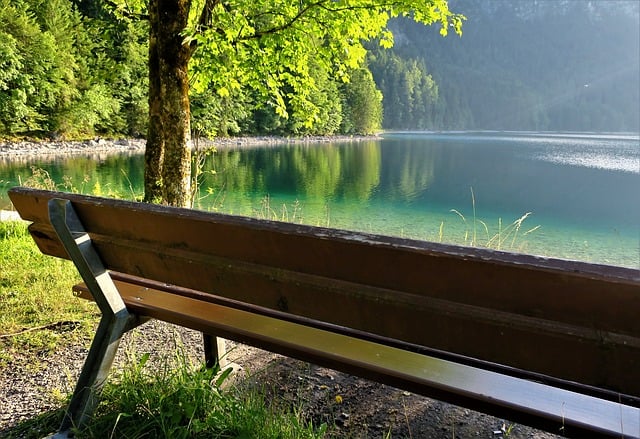
So I think it’s an excellent 1-inch compact for every day life.
Canon G9X II is also a great lightweight alternative when traveling.
Wi-Fi is a sweet bonus if you don’t travel with your laptop. Basically you can transfer your pics to your smartphone for editing and then post on social media (while on the trip).
Bottom line:
Canon G9X II is one of those pocketable cameras around $500 that will give you everything you need, even if you’re a DSLR enthusiast photographer.
In term of light traveling purposes, this is as good as you can get.
4. Panasonic Lumix LX100
Still a Great Compact Camera for Travel
Type: Large sensor compact | Weight: 393 g | Resolution: 13 MP | Sensor size: Four Thirds (17.3 x 13 mm) | LCD screen: Fixed | Touchscreen: No | Weather-sealed: No | ISO: Auto, 200-25600 (expands to 100-25600)
Reasons to Buy:
- 4K video
- very shallow DOF
- full manual controls
- hotshoe and 1/2000 flash sync speed
- Leica DC zoom lens and a M43 sensor
- compact and lightweight (perfect for travel)
- great low light performance and results at ISO 1600
Reasons to Avoid:
- EVF lag
- no external mic jack
- not the greatest battery life
- may have a dust on sensor problem
- not a tilting/articulated LCD screen
- awkward video record button position
Even though Panasonic Lumix LX100 was released in 2014, it’s still one of the top rated digital compacts.
If we consider all things LX100 offers, such as price, versatility, customizability, time-lapse feature, quality of video and stills, compactness and portability, then this might be one of the best photography deals you’ll come across.
And its micro 4/3 sensor with a fast f/1.7–2.8, 24–75mm zoom lens are a steal.
This large sensor camera offers exceptional versatility with its zoom range, making it ideal for various photography situations.
For comparison purposes, the price of Canon 24-70 mm f/2.8 lens ALONE is twice as much as the whole LX100 compact.
While you shouldn’t expect the same level of IQ as in high-end full frame DSLRs, Lumix LX100 still offers great quality.
(Even in low-light conditions).
You should keep in mind that it’s a product in the micro 4/3 sensor department, so it can’t be pushed too much. I’d say you can go up to ISO 3200 without seeing much noise.
Because of this lens, both video and still photos of this compact are stunning.
Overall, Lumix LX100 will work well for street photography, vacation and travel photos, food pics, and landscapes.
Oh, and the macro abilities of this Panasonic model are AMAZING.
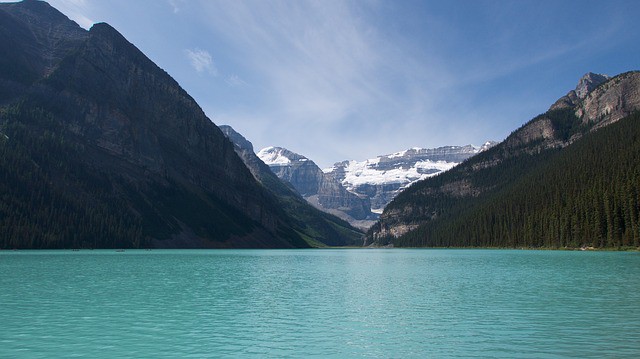
As you can see, its highly versatile lens has very little it can’t do… from landscapes to portraits.
While the lens is versatile it does have its minor drawbacks.
For example, you’d have awesome portrait shots but the it won’t give you that bokeh as an APS-C sensor with a f/1.4 can.
And if you’re taking landscape photos, the lens won’t be able to go as wide as a 15 mm lens.
This being said, while it’s discontinued in 2025, it’s still available and a great advanced point-and-shoot option for a lot of people.
You have a camera that:
- suitable for most photography styles,
- features a built-in time-lapse feature,
- is great for travellers as it’s light and portable,
- offers both video and stills of amazing quality, and,
- has a fixed zoom lens (no need to worry about additional lenses),
Keep in mind…
It has a challenging menu system and it might take you some time to figure out how to set it up. While this Lumix is very customizable, it’s something that beginner photographers might have a hard time with.
But if you’re familiar with manual controls, LX100 is awesome.
If you’re looking for a 4K travel camera that doesn’t involve interchangeable lenses, works for most situations, and is affordable enough, then LX100 is for you.
5. Ricoh GR II
Best Compact Wide Angle Camera 2025
Type: Large sensor compact | Weight: 251 g | Resolution: 16 MP | Sensor size: APS-C (23.7 x 15.7 mm) | LCD screen: Fixed | Touchscreen: No | Weather-sealed: No | ISO: Auto, 100-25600
Reasons to Buy:
- easy to use
- fast autofocus
- light, pocket-sized
- great image quality
- best value for price today
- 28mm lens (wide angle of view)
Reasons to Avoid:
- no tilting screen
- NOT for video shooting
- average battery life (get a spare DB-65 battery)
Ricoh GR II is special.
Why? Because unlike most cameras, this one was created for photographers BY photographers.
And so, all controls are in exact place where you expect/want them to be.
Ricoh GR II can be used for:
- macros,
- travel/family photos,
- shooting landscapes and nature,
- street photography,
- everyday life shots.
And because it features a 28mm lens, it offers a relatively wide angle of view and is a great choice for landscape shooting, as well as street photography if you come close to the subject.
Many consider this the best wide angle compact camera for its focal length and portability combination.
Ricoh GR II is pretty much legendary among street photographers.
I mean, check out all the GLOWING reviews it has on Amazon!
I think the only thing you’ll really miss is having a tilting screen (especially when shooting from unique angles). And be sure to grab a spare DB-65 battery.
All in all, Ricoh GR II sure is a great DSLR alternative.
It’s a budget-friendly, pocket-sized and has everything you need if you follow the “travel light” philosophy.
Now, if you consider image quality, size, and price, you’ll see how it’s probably the best value for money that you can get.
Without a doubt, it’s one of the best compact cameras for street photography today.
Note: If you can afford to spend extra few hundreds, then go for the Ricoh GR III (newer) model – it’s even better!
What Is a Sensor In a Digital Camera?
What’s the big deal about large sensors inside the cameras? Are big cameras better than small ones?
A large sensor allows you to:
- achieve high resolution,
- reduce crop factor,
- get high image quality in low light,
- increase the wide dynamic range of a photo,
- create a stronger amount of background blur, also known as “bokeh”.
Clearly, there are a lot of benefits to it.
Below is a quick video I recommend you watch:
That’s why all the good mirrorless and DSLRs have big sensors that are 1-inch or larger.
When shopping for a point and shoot camera with large sensor, you’re essentially getting many of these same benefits in a much more portable package.
And that’s why you want to get the best compact cameras WITH large sensors.
Frequently Asked Questions
Are compact cameras still worth it?
Honest answer: It depends on what your purpose for buying one (and of course your personal preference).
Compacts are very easy to use (compared to professional bodies). It offers a lot of features not normally seen on an average smartphone. It allows you to do more and explore photography in a whole new perspective.
If you plan to learn photography, then it could be worth buying your very own compact to start with. Although, only get a high end compact camera like Leica if you already have experience and desire to shoot consistently.
If you just want to have a camera to capture family events and travels (or even just everyday life), a compact with large sensor is ok, but a lot of people now use high-end smartphones for that purpose.
Ultimately, it’s up to you.
Do professional photographers still use compacts?
Many are wondering whether professional photographers still use compacts today. Most of the time, this kind of gear is seen as inferior compared to high-grade DSLRs and mirrorless ones.
So, are point-and-shoot still relevant in the lives of professional photographers?
Yes, most pro photographers likely have one premium compact in their collection. It’s likely they started practicing with it and was their first ever serious camera, or that they use it for purposes other than official photoshoot sessions.
Let’s face it:
Point-and-shoot offers convenience over heavy DSLRs, one reason why even pro photographers prefer bringing it during personal travels or during intimate family gatherings. Plus, it’s relatively easy to use making it a constant go-to gear for everyone.
Are point-and-shooters better than phone camera?
Compact cameras have strengths and features that may not be found in mobile phones. It generally has bigger sensors than most smartphones, so you can expect it to produce clearer and sharper images.
On the other hand, some very high-end smartphones can outdo the average point-and-shooters in terms of convenience and quality.
Some phone cameras even have as much as 64MP image resolution and full HD video recording at 1080p. The only downside about phones with amazing specs is that they normally have expensive price tags.
A lot of people prefer convenience and they just go with your phone and be more comfortable in taking pictures everywhere.
Heck, now there’s a new genre these days – smartphone/iPhone photography.
Do compact cameras have viewfinders?
Optical and electronic viewfinders are very common in mirrorless and DSLRs.
But do point-and-shooters have one of those, too?
In the past, it would be hard to find even one compact camera with a viewfinder. But in 2025, several models from popular brands like Sony and Fujifilm already include viewfinders.
One of the advantages of having this feature in a compact is that it allows you to shoot images even under the bright sun. If you are shooting outdoors and the sun is glaring, the LCD will be of no use (you can barely see anything as the sun’s light turns the screen almost black regardless of brightness settings).
And while most non-photographers rely on the rear LCD to see what the lens is capturing, photographers prefer seeing it through a viewfinder.
The reason is that viewfinders allow you to see proper subject framing and it also lets you see various settings before pressing the shutter button. This way, you can adjust the settings to your preference and liking.
Advanced large sensor compacts vs DSLRs?
With the recent advancement of compact cameras, many are asking whether it has the potential to replace the big and bulky DSLRs today.
Truth is…
Compacts (even those with large sensors) still cannot match the quality of images taken through a DSLR.
Of course, there are so many things to consider aside from sensor size, but it still has the most significant impact on any type of camera. The larger the sensor is, the better the image quality.
And as you may have already known, compacts really do have smaller sensors (hence the lighter they are, by the way) than their pro-grade rivals.
So even if you compare a compact and a DSLR both with 20MP photo resolution, you would see the difference between photo quality with one look.
Best Digital Compact Cameras 2025
As you can see, there are a lot of advantages to large sensor digital compacts.
Such cameras…
- offer amazing image quality,
- have a stronger bokeh effect,
- perform well in low-light conditions,
- are pocket-sized and therefore are great for travel,
I mean, what else can you ask for?
Here’s a recap of the products covered today:
5 Best Large Sensor Compact Cameras (2025)
- Leica Q – Hands down the best fixed-lens mirrorless camera money can buy.
- Fujifilm X100F – A great compact for travel and street photography in 2025.
- Canon G9X II – Best budget premium compact with 1-inch sensor (for travel).
- Panasonic Lumix LX100 – Great 4K point-and-shooter with micro 4/3 sensor.
- Ricoh GR II – Best value for money. Legendary among street photographers.
Bottom line:
If you’re looking for a travel camera or a camera specifically for street photography, one the compacts listed above should work for you regardless of your needs and budget.
Now…
While there are definitely other choices out there, I thought these 5 choices represented the largest sensor compact camera options currently available.
Each compact camera with large sensor in this list offers unique advantages for different photography styles and budgets.
And without doubt, these are great alternatives to bulky DSLRs.
Now, I’d like to hear from YOU!
- Do you prefer using a smartphone instead?
- Did you enjoy these compact camera reviews?
- What is your favourite compact camera with the biggest sensor?
Would love to hear your thoughts in the comments.
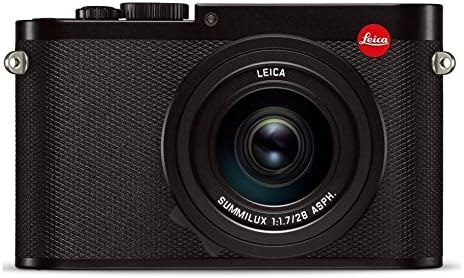
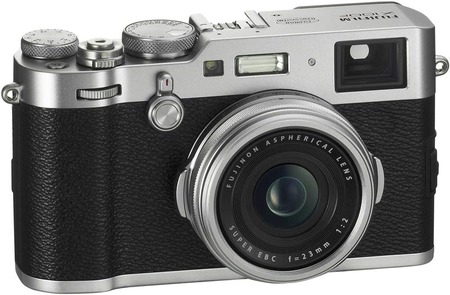
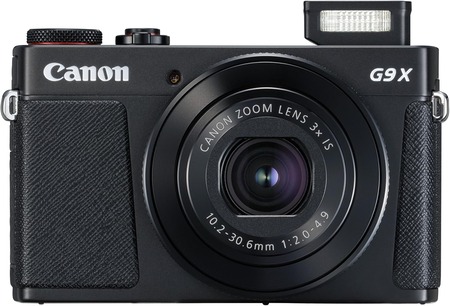
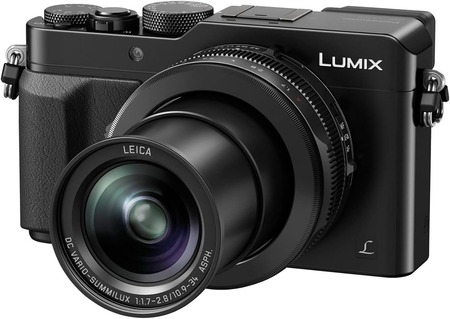

Great timing that I came across your post today, because I’m in the market for a new camera. I’ve just been using my phone, but I want to be able to take more detailed and professional looking photos for my blog and the phone just isn’t cutting it anymore. In your opinion, which would be the best camera to use to take photos of my kids’ baseball games, and could also be used to do product review photos?
Hi Shannon,
Yeah, more often than not, you’ll need a digital camera to take better pics. While smartphone cameras are great today, they still have small sensors (larger sensors means higher image quality even in low-light situations).
I happen to have relevant articles that you might want to read about:
– Top Rated Cameras for Instagram and Blog Photos
– Top Rated Sports Cameras (With The Lenses)
So…
Basically you’re looking for a camera that will serve the 3 main purposes:
– photos on your blog
– baseball games
– product photography
In my humble opinion the best choice for you is Canon Rebel T6i (here’s my in-depth review).
The reason I mention this camera in particular is because sports require fast frame rate and fast focusing and T6i happens to be the good camera on the low-end (under $1000).
I hope this helps!
Great list of big sensor compacts, Zarina. If I may add…?
I think other worthy cameras with the APS-C sensor are Fuji X70 (Ricoh GR’s direct competitor), the high-end Leica X-U and the whole Sigma Quattro family.
The cameras with the micro four-thirds sensor that I like are Panasonic Lumix DMC-LX100 and Leica D-LUX (Typ 109).
Canon PowerShot G1 X Mark II seems to be a great one with the 1.5 inch sensor (I think you mentioned it somewhere in your other articles before).
As for 1″-type sensor cameras… There are a lot of Panasonic compacts.
Also Leica V-LUX (Typ 114) is very good especially considering the price.
Many will agree with me when I say that it’s the Swiss Army knife amongst high end compact cameras with large sensors. (And a LOT cheaper than Leica Q).
Hey Emmanuel, thanks for your input. Definitely valid points you got there.
Leica cameras sure are great, whatever photography type you’re into. For me (as well as many other photographers) Leica Q is a dream camera.
The reason why I didn’t add Leica V-Lux to the list is because it’s a bit bigger than Leica Q and some would argue it’s not really that compact 🙂
Fujifilm X70 definitely is a good camera, especially for street photography, but as far as I know, a lot of street photography shooters prefer Ricoh GR II. Correct me if I am wrong.
As for Canon G1X II – I was thinking of adding it to the list but thought I’d stick to top 5 cameras. But I may add an “honourable mentions” section, so either I add G1X or G7X (because of it’s flip up screen for vloggers).
And yes, you’re right I did mention it a while ago as a good DSLR alternative to take for travel. Good memory!
I appreciate you taking the time to share your thoughts. See you around!
I’m trying to find a camera for night sky photography so I’ll check out Fujifilm X100F. Last time I tried to take a photo of a BEAUTIFUL moon with my phone was a disaster!
I’m also looking for one for using during a solar eclipse. I’m not even sure what kind of photography it’s considered… Any help would be really great!
Hi Jenny,
While certain smartphones do a pretty good job taking quality photos, shooting the moon is a whole new level (IMHO).
This list offers compacts that will be great for travel, macro, portraits and street photography.
Because these compacts come with large sensors they do well in low-light situations, but if you specialize in night/moon/eclipse photography, you might want to consider other options.
When it comes to photography equipment for moon photos, these are the things you’ll need:
1. Camera with manual settings
Capturing a quality shot of the moon is a rather difficult task, so you’ll need to be able to set certain parameters yourself (Auto mode isn’t your friend in this case).
Great if your camera has a wide dynamic range.
The simplest DSLR for you would be Nikon D3400 or D5000. (These are the cameras I recommend for beginner photographers too).
Alternatively, as an amateur, you might want to go with the superzoom compact camera (for example, Nikon Coolpix P900). It has manual settings and a 83x (!) optical zoom lens.
2. Camera lens
If you want to show the moon in a frame large enough, you must use a telephoto lens.
A good compact and budget telephoto lens is the Nikon 70-300mm f/4.5-5.6G ED-IF.
3. Tripod
If you want to get high-quality sharp shots of the moon, then you will definitely need a tripod.
I won’t go into details but basically it will help you with image stabilization.
Also a remote control is a nice addition to your tripod.
Jenny, I had a feeling you’re pretty new to photography, so I tried to give a simple explanation without going into details. However, you did give me an idea to write an article about shooting the moon and I will likely publish one sometime in the future.
I hope this helps!
Really appreciate this review. Since I’m old, I’m used to old cameras like my Canon F1. But I do currently use a canon 50d – although, I’m still lacking in digital know-how. I spend lots of time outside on trails usually backpacking/hiking. I’m looking to make a switch to something lighter, simpler, easier to use, but with the same kind of quality I get from my 50d. I do enlarge many of my prints and use as gifts for family; so, do you think the LX 100 would fit my mainly outdoor use? Again, appreciate your research here.
Hi Ken,
Some would argue that Panasonic LX100 is even a bit better than 50D and it certainly would be a good choice for backpacking/hiking/travel pics.
So, how big can you print with LX100?
As a rule, cameras with 13MP sensor (LX100 Mk I) can have great prints from 5×7″ to 20×30″ and 17MP sensor that’s seen in the newer LX100 Mk II can print from 5×7″ to 30×40″ with a good level of quality.
Point is, with the right skills and the amazing Leica lens that LX100 comes with, you can certainly make large prints for you and your family.
Now…
If you’re on a bigger budget, you may want to consider the upgraded Lumix LX100 II.
It has better battery life, great image quality, handling, and Panasonic say they addressed the dust issue seen in the first model (it was because of its collapsable lens and some photographers not being careful with it).
Hope this helps, Ken. Let me know if you have any further questions!
Hey Zarina,
Just an update – I actually spent more time on your reviews (along w/ videos), and actually purchased the Ricoh GR II as opposed to the Lumix. I mean, this was a tough decision for me! But, I have to say, Wow! I’m doing things w/ that little Ricoh that I had difficulty doing w/ my 50d. Especially black/white. Incredible. And after years of a gear bag, I’m now stashing my camera in my jeans pockets – so I’m carrying it ALL the time – like a wallet. Your info on sensors is what nudged me in the direction of the GR II. Just a quick question if you get a chance: Are there any precautions that would help eliminate the dust issue I’ve read about? (Like not carrying it jeans pockets.) Again, thanks for the comprehensive reviews. Cheers.
Hi Ken, good to hear from you again and congrats on your purchase!
If I knew you love black & white photography, I’d instantly tell you to go for Ricoh! I mean it’s the large sensor compact for B&W photos.
Anyway, thank you so much for taking the time to come back and share your thoughts/experience, I really appreciate it.
Your comment literally made my day.
Here’s the truth:
Yes, Digital World Beauty is supported by its readers who purchase via referral links to Amazon and while it’s great, it’s not the same as having truly grateful readers like you. I get a HUGE sense of satisfaction/fulfillment when I know I helped someone.
(That’s why I love my work on this website so much. It’s because I’m not selling, I’m HELPING.)
But I digress.
To address your concern with the dust issue on Ricoh GR II:
Of course, I don’t have any sort of stats who really had this issue but overall the dust was more present in its first version than version II. Will still provide you with some tips to how to avoid it, though.
Here they are…
Tip #1: You might know this but try not to shoot in real dusty place or directly against strong wind so no particles get sucked in.
Tip #2: One simple solution is to use your palm to cover the lens when you turn camera on/off (facing downwards).
Tip #3: Jeans pockets can indeed have dust/small particles so there’s a small risk. Perhaps try storing it in a secure camera bag?
Tip #4: Some say you shouldn’t get dust if you you don’t use over f:8.
Tip #5: I learned about this tip from lots of street photographers to help avoid any dust on Ricoh GR II.
So, get a GH-3 hood & adapter with this 49mm clear filter. You won’t need the hood but do use the lens barrel with a clear UV filter on the end (to seal off the lens).
This should prevent any small particles getting into the retractable lens. Now, I’m not sure if it isn’t long enough to fit your jeans but I’m certain the camera will still be pocketable in your jacket.
Watch this short video on YouTube to learn how to mount the GH-3 hood and adapter on Ricoh.
(Another good thing about tip #5 is that you’ll feel more confident if you decide to shoot during light rain.)
OK… I think this should be enough to make sure there are no dust issues 🙂
Hope this helps, Ken!
Let me know if you have any further questions.
P.S. Sorry about the late response, for some reason WordPress (the platform DWB is hosted on) started sending comments notifications to Junk folder and I only noticed yours from website’s admin backend.